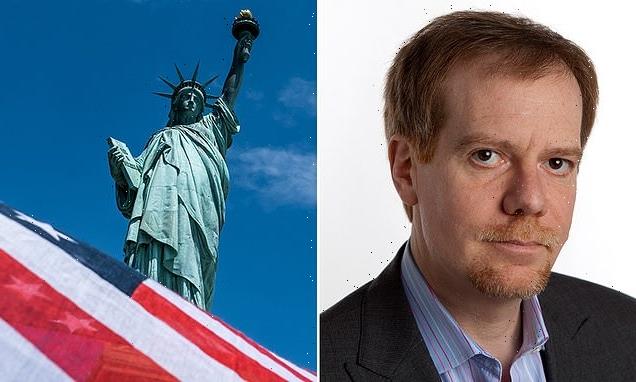Now the Statue of Liberty is cancelled! Washington Post writer claims famed figure is a ‘meaningless symbol of hypocrisy’ and ‘unfulfilled promises’
- Philip Kennicott, Pulitzer Prize winner, said statue no longer represented liberty
- Said it was a symbol of ‘unfulfilled promises’ due to America’s history of racism
- The journalist added that the statue was irrelevant to non-white Americans
The Statue of Liberty is a ‘meaningless symbol of hypocrisy’ because of America’s history of racism, sexism and anti-immigrant sentiment, according to the Washington Post’s art and architecture critic.
Philip Kennicott, a Pulitzer Prize winner, argued in an essay Saturday that the monument – which has stood for a century as one of the most iconic examples of American freedom – represented ‘unfulfilled promises’.
He added that the statue was irrelevant to non-white Americans, using as evidence the absence of representations of the statue when he visited a Chicano art exhibit at the Smithsonian American Art Museum in Washington.
The Statue of Liberty has been dragged into the culture wars by Washington Post writer Philip Kennicott
Many Twitter users disagreed vehemently with the attempt to drag Liberty into the culture wars, with one describing the piece as ‘woke cr*p’ and another calling Kennicott a ‘snobbish little scold’.
Kennicott’s essay, entitled, ‘Maybe it’s time to admit that the Statue of Liberty has never quite measured up,’ was accompanied by an illustration of the New York-based statue resting on someone’s fingertip.
He claimed that although the statue is as ‘familiar to some Americans as the flag, the statue is just as meaningless or foreign to others, a sign without significance, or worse, a symbol of hypocrisy or unfulfilled promises.’
Further on, he suggested that rather than representing freedom, the statue actually does the opposite due to America’s history of racism and sexism.
‘If the statue has had any kind of stable meaning over its lifetime, it is not as a symbol of liberty, but as a symbol of the misuse of liberty — as a hollow promise, unequally distributed and limited in its application to certain groups.’
Continuing his argument, he noted that the statue’s ‘ironies’ include it depicting a woman at a time when they did not have the right to vote.
Kennicott, a Pulitzer Prize winner, argued in an essay Saturday that the monument – which has stood for a century as one of the most iconic examples of American freedom – represented ‘unfulfilled promises’
Many Twitter users disagreed vehemently with the attempt to drag Liberty into the culture wars, with one describing the piece as ‘woke cr*p’
He also mentioned the fact it was erected in New York Harbor, partly with Chinese labor, not long after the US passed the Chinese Exclusion Act to restrict immigration from the country.
And in a nod to Donald Trump’s presidency, he added: ‘The noble sentiments of the poem by Emma Lazarus — ‘give me your tired, your poor, your huddled masses yearning to breathe free’ — were all but effaced in the past four years of strident and often violent anti-immigrant sentiment.’
One user, disagreeing with Kennicott’s view that the statue no longer meant anything to black or brown people, wrote: ‘Last month I visited the island to see Liberty. My white family was in the minority; the majority seemed to be from all over the world.
‘Non white families were generously represented, many in non western attire. I heard many languages. The world still loves Liberty.’
Another wrote: ‘This article is just another pathetic attempt to paint The Republic as systemically racist. Instead of cancelling and shaming history suggest you actually use your talent to contribute to a better future.’
Kennicott claimed that although the statue is as “familiar to some Americans as the flag, the statue is just as meaningless or foreign to others, a sign without significance, or worse, a symbol of hypocrisy or unfulfilled promises.”
Statue of Liberty: The French connection
Frenchman Edouard de Laboulaye first proposed the idea of a monument dedicated to freedom and liberty for the United States in 1865.
It was agreed that the American people were to build the pedestal, and the French people were responsible for the Statue and its assembly here in the United States.
The Statue was completed in France in July 1884 and arrived in New York Harbor in June 1885 aboard the French frigate ‘Isere.’ In transit, the Statue was reduced to 350 individual pieces and packed in 214 crates.
The Statue was reassembled on the pedestal in four months’ time. On October 28, 1886, President Grover Cleveland oversaw the dedication of the Statue of Liberty in front of thousands of spectators.
The Statue of Liberty was dedicated in 1886. It stands just over 305 feet tall
The Statue is 305 feet, 1 inch from the ground to the tip of the flame. It is the equivalent height of a 22-story building. In 1886, it was the tallest structure in New York.
Visitors can climb an interior staircase to an observation area inside the statue’s crown. The torch has been closed since the ‘Black Tom’ explosion of July 30, 1916, which was one of the largest acts of sabotage to the nation prior to the event of Pearl Harbor on December 7, 1941.
The torch is a symbol of enlightenment. The Statue of Liberty’s torch symbolically lights the way to freedom showing us the path to Liberty.
Even the Statue’s official name represents her most important symbol: ‘Liberty Enlightening the World’.
The Statue’s current replacement torch, added in 1986, is a copper flame covered in 24K gold.
It is reflective of the sun’s rays in daytime and lighted by 16 floodlights at night. The original torch was removed in 1984 and has been put on display in the new museum on Liberty Island.
Source: Read Full Article






